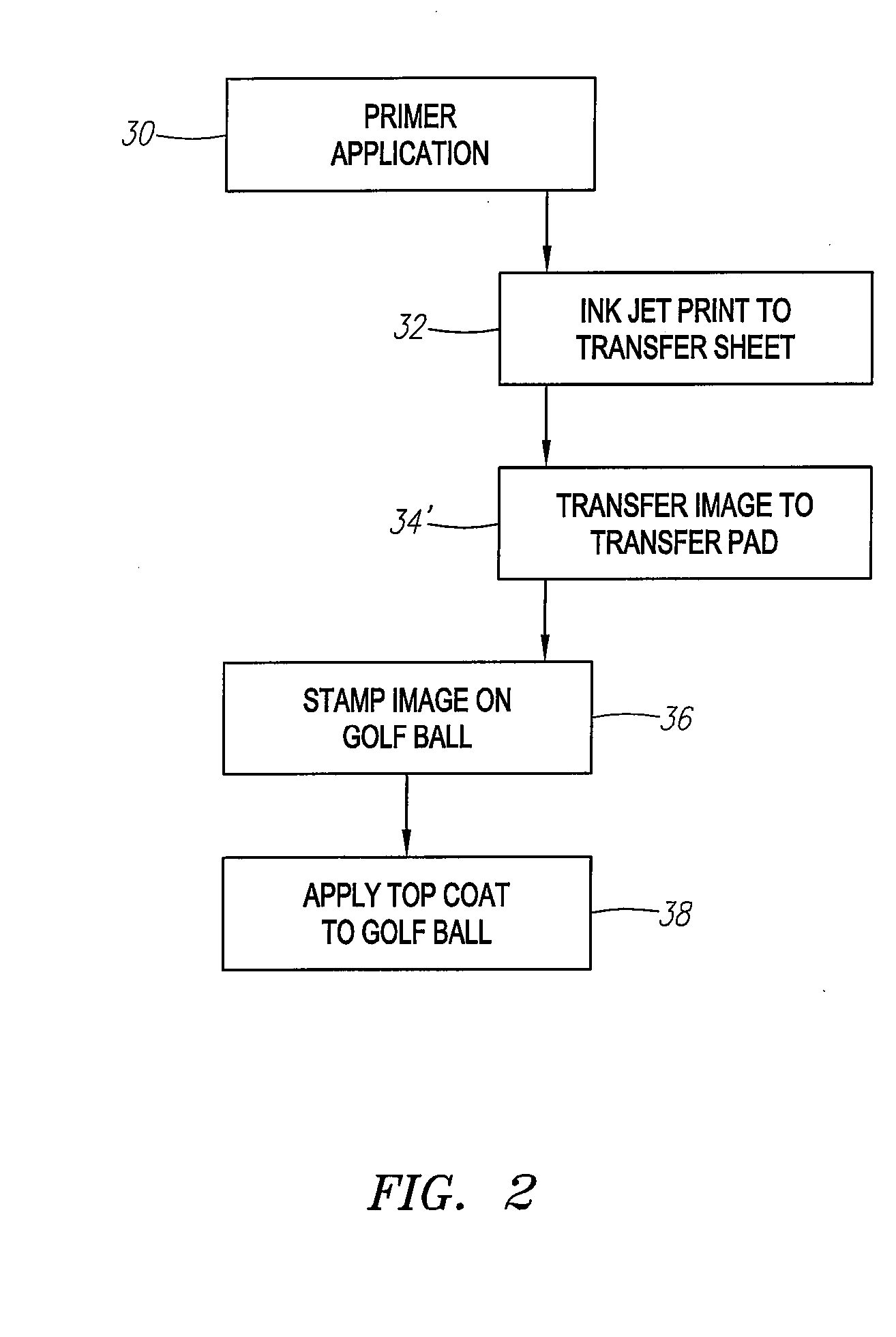Golf Ball
a golf ball and indicia technology, applied in the field of golf balls, can solve the problems of difficult screen printing on golf balls, many of the known uv curable inks that can be pad printed are not well suited for pad printing, and many of the known uv curable inks that can be pad printed are not suitable for golf balls. achieve the effect of quick and efficient transfer of logos
- Summary
- Abstract
- Description
- Claims
- Application Information
AI Technical Summary
Benefits of technology
Problems solved by technology
Method used
Image
Examples
example 1
[0082] A golf ball printing ink was prepared which contains:
[0083] 5 parts by weight 1,6 hexanediol diacrylate (sold by Sartomer, Exton, Pa.),
[0084] 17.5 parts by weight black pigment paste in diacrylate monomer, sold as Carbon Black UV Dispersion 99B415 (Penn Color, Doylestown, Pa.),
[0085] 35 parts by weight of an aliphatic urethane acrylate oligomer (CN965, sold by Sartomer, Exton, Pa.),
[0086] 0.5 parts by weight isopropyl thioxanthone, C16H14OS, a sulfur-type photoinitiator (ITX, distributed by Aceto Chemical, Lake Success, N.Y.),
[0087] 1 part by weight ethyl 4-dimethylamino benzoate, C11H15NO2, an amine-type photoactivator (EDB, distributed by Aceto Chemical, Lake Success, N.Y.),
[0088] 4.4 parts by weight xylene solvent, and
[0089] 4.4 parts by weight butyl acetate solvent.
[0090] The photoinitiator and photoactivator were dissolved in the xylene / butyl acetate solvent blend. The ink was pad printed using a silicone pad or unprimed, dimpled ionomeric covers of several dozen...
example 2
[0093] The procedure of Example 1 was repeated with excepting that the ink formulation that was used contained:
[0094] 10 parts by weight 1,6 hexanediol diacrylate (sold by Sartomer),
[0095] 35 parts by weight black pigment paste in diacrylate monomer, sold as Carbon Black UV Dispersion 99B415,
[0096] 70 parts by weight of a difunctional aliphatic urethane acrylate oligomer (Ebecryl 4833 sold by UCB, RadCure, Inc., Smyrna, Ga.),
[0097] 1 part by weight isopropyl thioxanthone, C16H14OS (ITX), and
[0098] 2 parts by weight ethyl 4-dimethylamino benzoate (EDB).
[0099] The ink had a viscosity of about 25,000 cps. The ink was cured in about 1 second and produced a film having a Sward hardness of about 12. The balls were subjected to the wet barrel durability test procedure. After the wet barrel durability testing, it was found that no more than about 20% of the ink logo was removed.
example 3
[0100] The procedure of Example 1 was repeated excepting that the CN965 oligomer was replaced by a difunctional oligomer sold as Ebecryl 8402 (UCB RadCure, Inc., Smyrna, Ga.). The ink had a viscosity of about 18,000 cps. The ink was cured in about 1 second and produced a film having a Sward hardness of about 14. The ink was found to be as nearly as durable as that of Examples 1 and 2.
PUM
| Property | Measurement | Unit |
|---|---|---|
| thickness | aaaaa | aaaaa |
| wt % | aaaaa | aaaaa |
| wt % | aaaaa | aaaaa |
Abstract
Description
Claims
Application Information
 Login to View More
Login to View More - R&D
- Intellectual Property
- Life Sciences
- Materials
- Tech Scout
- Unparalleled Data Quality
- Higher Quality Content
- 60% Fewer Hallucinations
Browse by: Latest US Patents, China's latest patents, Technical Efficacy Thesaurus, Application Domain, Technology Topic, Popular Technical Reports.
© 2025 PatSnap. All rights reserved.Legal|Privacy policy|Modern Slavery Act Transparency Statement|Sitemap|About US| Contact US: help@patsnap.com



